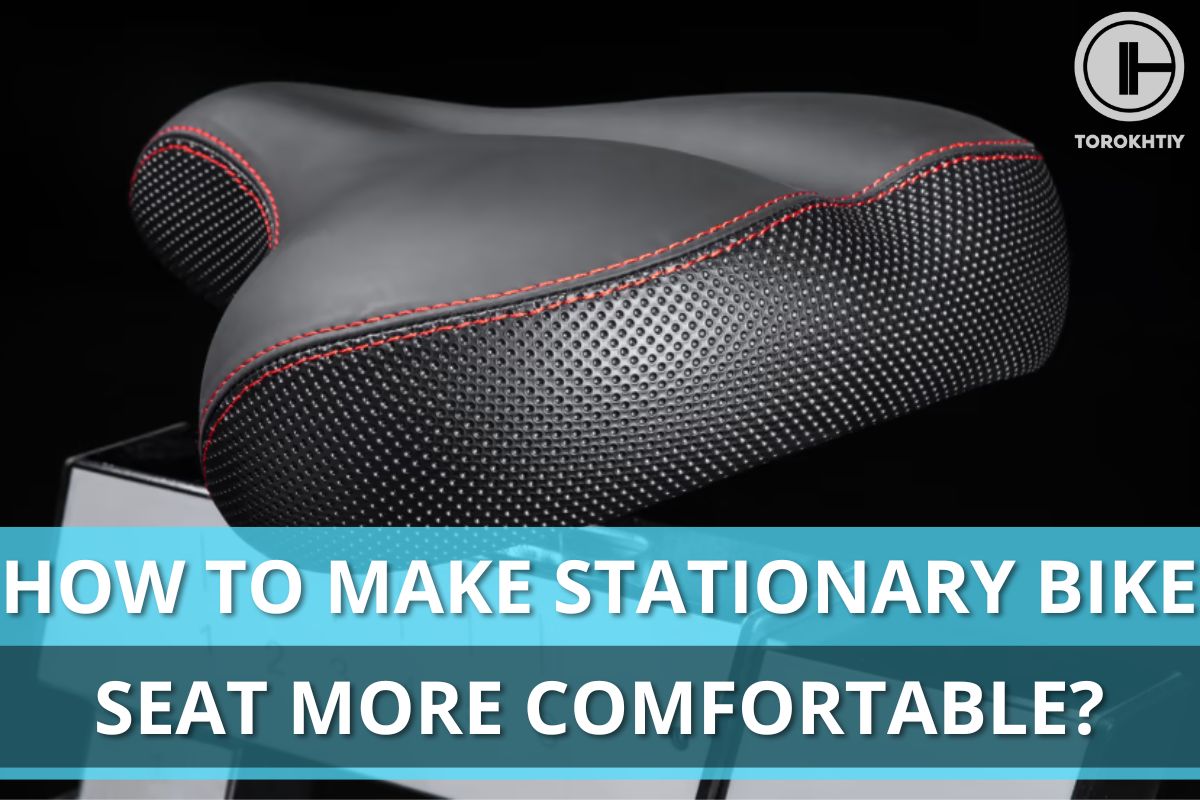Riding a stationary bike can be tough on your seat. Comfort matters when cycling for long periods.
Many people experience discomfort on stationary bike seats. This can lead to shorter workout sessions or even avoiding the bike altogether. Luckily, there are simple ways to improve your experience. Adjusting the bike seat, using padded covers, and wearing the right gear can make a huge difference.
With a few tweaks, you can enjoy longer, more comfortable rides. This blog will guide you how to make stationary bike seat more comfortable. Get ready to ride pain-free and make the most of your workout sessions!
Table of Contents
Choosing The Right Seat
Choosing the right seat for your stationary bike can significantly enhance your comfort. Many cyclists experience discomfort due to an ill-fitting seat. Finding the perfect seat can alleviate pain and make your rides more enjoyable.
Types Of Seats
There are various types of seats available. Each type caters to different needs. Some common types include racing seats, comfort seats, and gel seats.
Racing seats are narrow and designed for speed. Comfort seats are wider with extra padding. Gel seats provide a balance of comfort and support. Selecting the right type can make a big difference in your cycling experience.
Seat Padding Options
Seat padding can affect your comfort level. There are different padding options to consider. Foam padding is common and offers good support. It is durable and maintains its shape well.
Gel padding conforms to your body. It provides extra cushioning. This option is great for reducing pressure points. Consider your preferences and riding style to choose the best padding.

Credit: www.youtube.com
Adjusting Seat Position
Finding the perfect stationary bike seat position can make a big difference in your comfort and performance. Adjusting your seat position correctly helps avoid pain and injuries. Let’s explore how to adjust the seat height and angle.
Seat Height
Adjusting the seat height is crucial for a comfortable ride. Follow these steps:
- Stand next to your bike. The seat should be level with your hip.
- Sit on the bike. Place your heels on the pedals.
- Pedal backward. Your legs should be fully extended at the lowest point.
- Adjust the seat height if needed. Your legs should not be overextended.
If your knees bend too much, raise the seat. If your hips rock side to side, lower the seat.
Seat Angle
The seat angle affects how your weight is distributed. A level seat is ideal for most riders. Adjust the angle with these steps:
- Loosen the seat clamp under the seat.
- Tip the seat forward or backward slightly.
- Tighten the seat clamp again.
- Sit on the bike. Make sure the angle feels comfortable.
If you feel pressure on your hands or lower back, adjust the angle again. A level seat usually works best.
Using Seat Covers
Using seat covers is a great way to make your stationary bike seat more comfortable. They can provide additional padding and support, reducing discomfort during long rides. There are various types of seat covers available, with gel and foam covers being the most popular options.
Gel Covers
Gel seat covers are known for their softness and flexibility. They conform to your body’s shape, offering customized support. This helps in reducing pressure points and distributing weight evenly. Many riders prefer gel covers for their plush feel.
- Soft and flexible
- Conforms to body shape
- Reduces pressure points
- Even weight distribution
Gel covers are also easy to install. Simply slip them over your existing seat. They can be removed and washed, maintaining hygiene. This makes them an excellent choice for those who ride frequently.
Foam Covers
Foam seat covers offer a firmer feel compared to gel covers. They provide excellent support and are great for longer rides. Foam covers are designed to absorb shocks, reducing the impact on your body.
- Firmer feel
- Excellent support
- Shock absorption
- Ideal for long rides
Foam covers are durable and maintain their shape over time. They are also easy to install and remove. This makes them a practical option for both casual and serious riders.
In summary, choosing between gel and foam seat covers depends on your personal comfort preference. Both options provide significant benefits, enhancing your riding experience.
Wearing Proper Cycling Attire
Wearing proper cycling attire can make a huge difference in your stationary bike experience. The right clothes can reduce discomfort and improve your overall ride. Here are some key points to consider:
Padded Shorts
Padded shorts are essential for a comfortable ride. They provide cushioning and reduce pressure on sensitive areas. The padding helps absorb shock and prevent chafing.
Look for shorts with a seamless design. This design reduces friction and skin irritation. A good fit is crucial too. The shorts should be snug but not too tight.
Here are some key benefits of padded shorts:
- Extra cushioning for long rides
- Reduces pressure on the sit bones
- Minimizes chafing and irritation
Breathable Fabrics
Wearing breathable fabrics can enhance your comfort. These materials wick away sweat and keep you cool. They allow air to circulate, which reduces overheating.
Choose fabrics like polyester or nylon. These materials are lightweight and dry quickly. Avoid cotton as it absorbs moisture and stays wet.
Here are the advantages of breathable fabrics:
- Wicks away moisture
- Keeps you cool and dry
- Reduces the risk of rashes
Proper cycling attire, including padded shorts and breathable fabrics, can significantly enhance your stationary bike experience. Focus on comfort and functionality to enjoy a more pleasant ride.
Maintaining Good Posture
Riding a stationary bike is a great way to stay fit. Yet, an uncomfortable seat can ruin the experience. One key factor to improve comfort is maintaining good posture. Keeping a proper posture helps prevent pain and discomfort during your ride.
Core Engagement
Engaging your core muscles is vital. It helps you keep balance and reduces strain on your back. Keep your abdominal muscles tight but not tense. This stability will make your ride smoother.
Here’s a simple way to engage your core:
- Sit upright on the bike.
- Pull your belly button towards your spine.
- Hold this position while breathing normally.
Repeat this exercise frequently. It helps to keep your posture correct and prevents slouching.
Back Alignment
Maintaining a straight back is crucial for comfort. A curved or hunched back can lead to pain.
Follow these steps for proper back alignment:
- Adjust the seat height. Your legs should be almost straight at the lowest pedal point.
- Keep your back straight. Avoid leaning too far forward.
- Ensure your shoulders are relaxed. Do not hunch them.
Use a mirror if possible. It helps you check your posture while riding.
Here’s a quick table for easy reference:
| Tip | Action |
|---|---|
| Core Engagement | Pull your belly button in, hold, and breathe. |
| Back Alignment | Adjust seat height and keep back straight. |
Good posture not only boosts comfort but also improves your workout efficiency. Keep these tips in mind to make your ride more enjoyable.
Incorporating Breaks
Incorporating breaks during your stationary bike sessions can greatly enhance comfort. Regular pauses reduce muscle fatigue and discomfort. Taking short intervals and stretching can make a big difference. Let’s explore the details.
Short Intervals
Short intervals can help. Aim for a break every 10-15 minutes. This gives your muscles a chance to rest. Stand up and walk around. This can improve blood flow and reduce tension. It also helps in avoiding numbness. Small breaks can make long sessions more bearable.
Stretching
Stretching is key. Simple stretches can ease tight muscles. Focus on your legs, back, and hips. Gentle movements can increase flexibility. This can reduce the risk of pain. Stretching also promotes better circulation. Make it a habit to stretch during breaks.
Using Cushions And Pads
Ensuring a comfortable ride on your stationary bike can make a huge difference in your workout experience. Using cushions and pads on your bike seat can provide the extra comfort and support you need.
Seat Cushions
Seat cushions are an excellent way to enhance the comfort of your stationary bike. They come in various shapes and sizes, designed to fit most bike seats. These cushions often feature memory foam or gel, which adapts to your body shape and offers a softer surface. Here are some key benefits:
- Improved Comfort: Reduces pressure points and pain.
- Easy to Install: Quickly attach and remove.
- Affordable: Cost-effective solution for a more comfortable ride.
Consider choosing a cushion with a non-slip bottom to ensure it stays in place during your ride. Some popular materials include:
| Material | Benefits |
|---|---|
| Gel | Excellent shock absorption |
| Memory Foam | Molds to body shape |
| Hybrid | Combines gel and foam benefits |
Additional Padding
For even more comfort, consider additional padding options. These can be used in conjunction with seat cushions or on their own. Here are some methods to add extra padding:
- Padded Shorts: Wear cycling shorts with built-in padding.
- Seat Covers: Use padded seat covers for extra cushioning.
- Foam Inserts: Place foam inserts under your cushion.
Additional padding can significantly reduce discomfort and improve your overall experience. Ensure that any added padding is securely in place to prevent movement during your ride. This will allow you to focus on your workout without distraction.
Regular Maintenance
Keeping your stationary bike seat comfortable requires regular maintenance. With a few simple steps, you can ensure a pleasant ride every time. Regular care helps prevent discomfort and prolongs the life of your bike seat. Let’s explore some key maintenance tasks.
Tightening Screws
Loose screws can cause the seat to wobble. This can lead to an uncomfortable ride. Regularly check and tighten all screws. Use the correct tools to avoid damaging the screws. Make sure the seat is stable and secure.
Cleaning The Seat
Regular cleaning keeps the seat comfortable. Dirt and sweat can build up over time. Wipe the seat with a damp cloth. Use mild soap if needed. Avoid harsh chemicals as they can damage the material. Dry the seat thoroughly after cleaning.

Credit: torokhtiy.com
Frequently Asked Questions
How to Make Stationary Bike Seat More Comfortable?
To make your stationary bike seat more comfortable, adjust the height and angle of the seat. Adding a gel seat cover or padded shorts can also help.
Why Does My Bike Seat Hurt?
Your bike seat may hurt due to improper adjustment, lack of padding, or incorrect riding posture. Ensuring proper fit and using padded shorts can alleviate discomfort.
What Is The Best Seat Padding For Stationary Bikes?
Gel seat covers and padded bike shorts are the best options for adding extra cushioning and comfort to your stationary bike seat.
How Do I Properly Adjust My Bike Seat?
To adjust your bike seat, ensure it is level, at the correct height, and positioned to allow a slight bend in your knee when pedaling.
Conclusion
Making your stationary bike seat more comfortable is achievable with simple steps. Adjust the seat height for better alignment. Use padded shorts to reduce pressure. Invest in a quality gel seat cover. Take regular breaks to prevent discomfort. Proper posture also helps.
Experiment with different adjustments until you find what works. Prioritize comfort to enjoy longer rides. Happy cycling!

